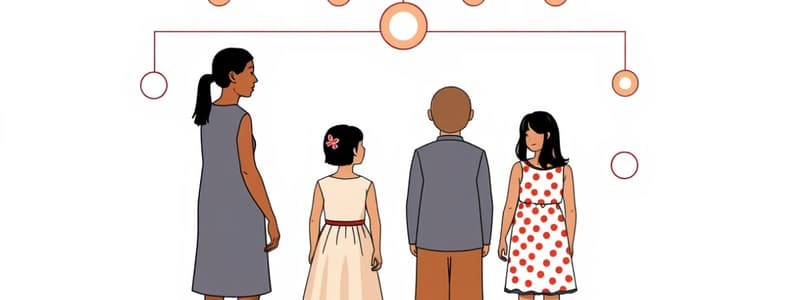Podcast
Questions and Answers
What is a kindred?
What is a kindred?
Individual traces descent through both parent and grandparents on both sides.
Why do some food foragers and industrialized societies have kindreds?
Why do some food foragers and industrialized societies have kindreds?
It is essential to know the family's line through both sides.
What is bilateral kinship?
What is bilateral kinship?
Person tries their ancestry through both parents.
What are consanguineal kin?
What are consanguineal kin?
What are the four types of descent groups?
What are the four types of descent groups?
What is a lineage?
What is a lineage?
Marriages can occur within a lineage.
Marriages can occur within a lineage.
What is unilineal descent?
What is unilineal descent?
What is a patrilineage?
What is a patrilineage?
Which members are included in a patrilineage? (Select all that apply)
Which members are included in a patrilineage? (Select all that apply)
Which members are excluded from a patrilineage? (Select all that apply)
Which members are excluded from a patrilineage? (Select all that apply)
What subsistence strategies are associated with patrilineal descent?
What subsistence strategies are associated with patrilineal descent?
What is a matrilineage?
What is a matrilineage?
Which subsistence strategy is associated with matrilineal descent?
Which subsistence strategy is associated with matrilineal descent?
Matrilineal descent means that a society is matriarchal.
Matrilineal descent means that a society is matriarchal.
What is a clan?
What is a clan?
What is a phratry?
What is a phratry?
What is a moiety?
What is a moiety?
How does New Reproductive Technology relate to kinship and descent?
How does New Reproductive Technology relate to kinship and descent?
Flashcards are hidden until you start studying
Study Notes
Kindred and Bilateral Kinship
- Kindred involves tracing descent through both maternal and paternal lines.
- Both food foragers and industrialized societies utilize kindreds for understanding family lineage from both sides.
- Bilateral kinship recognizes ancestry from both parents, maintaining equal importance in emotional and wealth-related ties.
- Consanguineal kin refers to family connections established through marriage.
Types of Descent Groups
- Four major types of descent groups: Lineage, Clan, Phatry, Moiety.
Lineage Characteristics
- Lineage is a corporate group of consanguineal kin with a common ancestry established through genealogical links.
- Functioning as an economic unit, lineages prohibit marriages within to avoid relations.
- Unilineal descent traces ancestry through one gender only.
Patrilineage Insights
- Patrilineage traces ancestry exclusively through the father's side of the family.
- Included members: Ego, Ego's father, siblings, father’s siblings, and their children.
- Excluded members: Ego’s mother and her lineage, as well as father's sister's children.
- Associated subsistence strategies include intensive agriculture and pastoralism, with a patrilocal residence pattern.
- Patriarchal societies are characterized by male dominance in economic and political roles; the U.S. exemplifies this structure.
- The Traditional Han in China is an example of a patrilineal society, providing economic assistance through patrilineage.
Matrilineage Characteristics
- Matrilineage traces ancestry through the mother’s side.
- Included members: Ego, Ego's mother, siblings, mother's siblings, and their children.
- Excluded members: Ego’s father and his lineage, as well as mother’s brother's children.
- Associated with horticultural subsistence strategies and matrilocal residence.
- Societies with this lineage structure do not inherently mean they are matriarchal.
- Examples include the Hopi in Northeastern Arizona and the Mosuo in Southwestern China.
- The Mosuo practice consanguineal family structures with inheritance passed down the maternal line.
- Economic decisions are made by females, while males handle political decisions in both Mosuo and Hopi societies.
Clan and Social Structure
- A clan consists of multiple lineages claiming a common ancestry, either real or fictive.
- Clan members do not need to be biologically related, functioning like Western symbols such as colleges and sports teams.
- Functions of clans include promoting solidarity, regulating marriages (exogamous), and fulfilling ceremonial and political roles.
Phratry and Moiety
- Phratry is a collective of clans that may have common ancestry, but genealogical links may not be assured.
- Moiety represents groups of phratries claiming ancestry.
- Both phrases facilitate institutionalized reciprocity, establishing numerous relationships.
- Canela of South America organizes their settlement patterns around descent groups, with clans divided into moieties.
Kinship Terms and Relations
- Kinship terminology often overlaps, with multiple relatives sharing the same designation due to relational similarities.
- Adopted individuals count as related kin, emphasizing the relational aspect beyond biological connections.
Eskimo Kinship System
- In this system, consanguineal kin are identified using specific kinship terms; certain relatives are bifurcated while others are merged.
- Eskimo kinship systems are seen in societies where kinship terms reflect nuclear family ties.
Hawaiian Kinship System
- Consanguineal kin are recognized through generational terms, indicative of parent and child relationships.
- The Hawaiian system is termed generational due to its focus on sibling and cousin relations across generations.
Iroquois Kinship System
- The Iroquois system shares similarities with the Hawaiian system regarding kinship terms.
- Distinctions occur between mother's brother's children (referred to as parallel cousins) and father's sister's children (cross cousins).
- Kinship terms differ due to variations in familial relationships, highlighting cultural nuances in kinship classifications.
New Reproductive Technology and Kinship
- New reproductive technologies intersect with kinship and descent, complicating traditional definitions of parenthood.
- In scenarios where donor gametes are used, cultural perceptions determine maternal and paternal identities.
- Kinship is seen as a socially constructed status, guided by cultural definitions of relationships and familial ties.
Studying That Suits You
Use AI to generate personalized quizzes and flashcards to suit your learning preferences.




